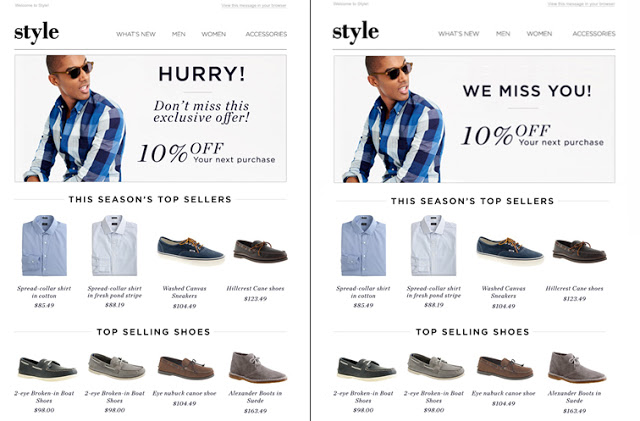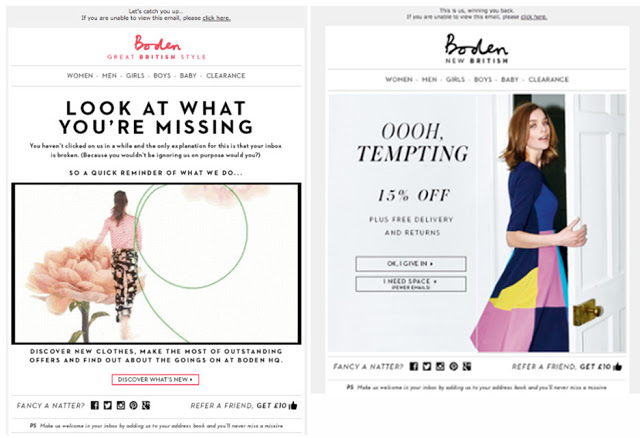Chronic non-openers. How to return a client is not too late ...

Internet business has not been suffering from the problem for the first year, that the subscriber base is overflowing with “not active” clients. They do not open your letters, and they do not unsubscribe from the newsletter.
There are a lot of controversies around this topic about whether it’s worthwhile to remove such subscribers from your database on your own ... And this argument is eternal.
')
A study conducted by Econsultancy shows that, on average, 61% of subscribers in the database are “not active”.
This means that 2/3 of the subscribers on your list have not opened a single letter from you for a month. And this negative factor affects various areas of your business in the form of:
- Loss of potential income
- ROI drops
- Email marketing metrics distortion
- Problems with the deliverability of letters
In such a situation, it is important to reactivate as many of these “inactive” subscribers as possible and, at the same time, not to lose active ones. And those who cannot be reactivated will have to be permanently removed from your base before it is too late.
We define "not active".
I understand that the previous proposal immediately provoked a strong reaction and indignation. And that's fine. After all, you have invested so much labor and money in collecting this base and are in no way ready to give it away without a fight.
In general, there is a chance that someday they will still open your letter, right?
After all, they subscribed to your newsletter for a specific purpose and agree to receive letters from you.
And all these thoughts are correct. It is really difficult to permanently erase the email of the client whom you so easily attracted, courted and tried to return. But there comes a time when it will be much more useful for your business to get rid of these subscribers rather than continue trying to reach them.
In order to correctly identify such subscribers, start with the fact that what client in your business can be considered “not active”?
Most online stores are determined by such customers by the parameters: “does not open letters”, “does not visit the site” or “does not buy” for a certain period of time. This time period usually lasts from 3 to 12 months.
Ideally, select all 3 segments and work with each separately . Customers who have not visited the site for a long time or did not buy should be led to the transition to the site and a new purchase.
Those who “chronically” do not open your letters, you need to get to start reading your mailings. And it is to this segment to pay the most attention.
Act before it's too late ...
The best thing we can do in the fight against non-openers is to prevent as many customers as possible from falling into this very segment. The easiest way to do this is to add a separate letter to the trigger chain for those who have not opened the previous one.
Set up sending the second letter to those who did not open the previous one. Leave the text of the letter the same, change only the subject.
This method should be used absolutely for all your mailings. The main thing is to think carefully about the time of sending the second letter and its subject. It is likely that having received the letter at another, more convenient time, the client will nevertheless open it.
At the same time, the chronic “non-discoverer” of your letters requires more attention and effort. After all, these people did not open your letters for weeks or months. A few strategic tips on how to work with such subscribers to get them back:
Start reactivating them as soon as possible.
Start with the “have not opened letters in the last 30 days” segment, then 60, 90 and 180 days. It does not take much time and effort. Simply replace the subject of the letter and the text pre header to reach a different audience.
For example, a letter on the left can be sent to those who have not opened the letter within 30 days, and on the right - 90 days.

By adding special importance to these customers and paying them attention, you will prevent some of them from falling into the “inactive” segment .
In 2014, the company Return Path conducted a study (33 brands were studied that introduced reactivation mailings), which showed that the open-rate after such mailings increased by 13%.
Another 75% of clients began to open letters within 89 days and 25% after 300 days of such mailings.
Use personalization to increase the relevance of letters.
The more personal your letters are, the more effect you will get. Add personal recommendations based on products that a customer has previously watched or purchased.

You can also segment your customers and send a different offer to each group. For example, the Boden store sends a letter on the left to those who opened the letter, but did not click on the link. Letter to the right of those who did not open the previous letter.

Automate these mailings. Do not send them manually.
It is very important to constantly remind your customers that you miss them and wait for them to go shopping. You must admit that it is difficult to constantly filter your customer base, the history of purchases and visits to the site, upload the mailing list, upload it to the postal service and make mailings.
It is much easier to automate this process. You will always be sure that not a single client has been left unattended and your managers will have free time to do more important tasks.
There are examples of companies that sent 4-6 emails within 30 days to reanimate customers who are not active during the last 6 months. And these examples are successful.
It is important that during the sending of these resuscitation letters, these subscribers do not receive any other mailings from you. Remove them from all other lists until they start reading your mailings and making purchases again.
An excellent example of a reactivation letter is to ask the client, perhaps he wants to register on your mailing list and at the same time offer him a 20% discount if he decides to return to you.

This chain of 4 letters was sent to customers who did not open previous letters for 4 months until they opened it.
All 4 times the letter was the same, only the headers changed.
- Email # 1: “Do you still remember us?”
- Email # 2 (10th day): “See what you are giving up ...”
- Email # 3 (20th day): “Do not open this email!”
- Email # 4 (30th day): “Maybe we should leave?”
When you work with “not active” clients, feel free to be creative in headlines. These people don't read your newsletters anymore, so you have nothing to lose :)
Know the measure, so as not to harm your brand, while not using headlines like “20% discount only today!”. Even in spite of the attractive size of the discount, whether such a letter theme is likely to catch the eye of your client among hundreds of other letters in its Inbox.
If that doesn't work, can I try something else?
Yes, because you have the email addresses of all these customers and many other channels of interaction with them. For example, try remarketing ( Remarketing allows you to re-apply to the audience with whom you have already interacted. For example, if a user visited your site but did not buy anything, you can show him relevant ads on other web sites ).
Advertising on Facebook, Twitter, banner advertising, push-notifications ... There are plenty of options, for every taste and budget.
When will I see the result?
Reactivating customers is worth the wait. You will receive not only the growth of the discoveries of your letters, but also clicks, and most importantly sales. But even those who remain unmoved will benefit you. The fact that you can now pinpoint the list of these clients and exclude them from your subsequent mailings is very important.
First, you will protect your reputation as a sender and the deliverability of letters. Secondly, save the budget without sending letters to those to whom they are not interested.
Successes!
Source: Listrak company blog .
Source: https://habr.com/ru/post/301992/
All Articles